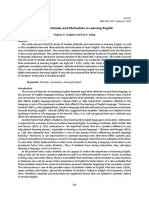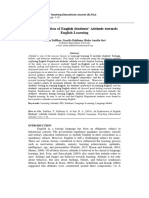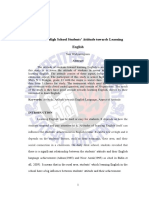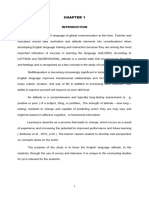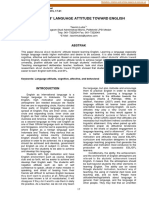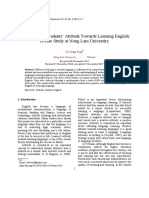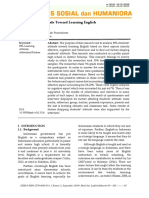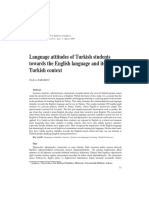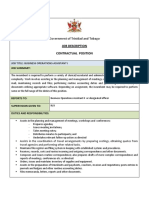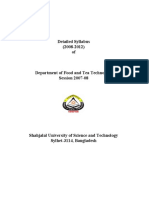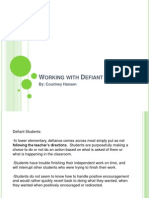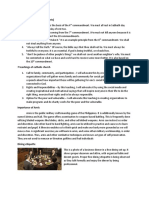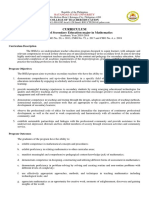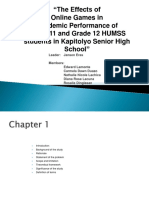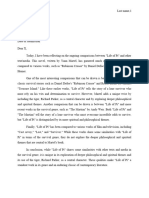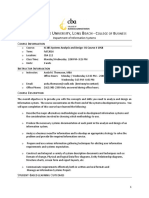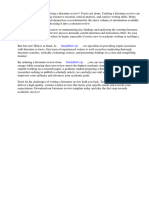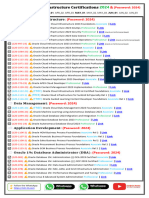Name: John Reymart B.
Tuna Section: A200
Language Learning Attitude of Student
A descriptive quantitative research design through the use of survey method was
employed in this research study. The data were collected using a 15-item, 5-point Likert
scale questionnaire as part of their process. The study subjects were also 15 randomly
chosen education major college students of St. John Paul II College of Davao, who were
officially enrolled in the second semester of the Academic Year 2017–2018. For the
interpretation of the students' attitude in learning language, the study employed the mean
rating to examine the data.
Result and Discussion
Research Question: What is the level of language learning attitude of students?
Table 1. Descriptive Summary of the Mean Scores from 15 Respondents for Each Item
Question Number Total Rate Mean Rate Descriptive
Equivalent
1 86 4.53 Very High
2 57 3.8 High
3 66 4.4 High
4 63 4.2 High
5 58 3.87 High
6 44 2.93 Moderate
7 4- 2.67 Moderate
8 56 3.73 High
9 56 3.73 High
10 54 3.6 High
11 58 3.87 High
12 57 3.8 High
13 40 2.67 Moderate
14 73 4.87 Very High
15 65 4.33 High
Table 1 above indicates the respective equivalent of the mean rating of the
students for each of the questions administered in the survey. Fifteen students were
polled and out of the 15-item questionnaire, the highest mean rate of question number 14
was 4.8666667 with a total rate of 73, which is very high descriptive equivalent. Very high
�rating for questions indicates that the learning attitude of the student towards such a
question is always expressed. And high rating indicates that language learning attitude is
often expressed. Moderate indicates language learning attitude is sometimes expressed.
Low indicates that it is seldom expressed and very low indicates that it is never expressed.
Most of the rating of the students in the survey questionnaire is moderate to very
high. The finding shows that the language learning attitude of the students is positive.
There are several determinants of the language learning attitude of the students.
Language attitude, in a definition borrowed from the Longman Dictionary of Applied
Linguistics and Language Teaching (2002), is the way individuals think about their own
language and other individuals' language, which has the ability to affect whether or not
they want and are able to learn it. The attitude has the potential to affect language learning
based on the way learners think about its difficulty, value, or social standing. This notion
justifies the interpretation of the students' mostly positive answers. In the research study
conducted by Getie (August 07, 2019), it illustrated how the positive attitude in learning
significantly came from the social context such as peer groups, or learning from
individuals who use English as their mother language. This is also justified by the rating
on question 11, where the students provided a high rating on learning in an "All English"
environment. An explanation of the positive attitude of the respondents towards language
acquisition is Bandura's social cognitive theory in which the learning behavior or interest
of learners is greatly affected by personal factors, the environment, and behavior itself
(Health Behavior and Health Education, n.d.). In short, as discussed in Table 1, the
positive level of language learning attitude of the students since there are no low ratings
from the students, indicating that they are in good social surroundings that promote a
positive language learning attitude.
There have been several studies examining the various factors influencing the
attitudes of learners towards learning a language. Gardner and Lambert (1972) socio-
educational theory emphasized integrative motivation—when learners are motivated by
a real interest in learning the language and culture. This contrasts with instrumental
motivation, when learners are motivated by concrete benefits such as employment.
Recent research by Dörnyei (2001) explains how motivational self-system and classroom
climate control learners' attitudes towards learning a language. Further, Krashen's (1982)
Affective Filter Hypothesis proposes that motivation, anxiety, and self-confidence are the
key influences in the achievement of second language acquisition. These vital theories
shed light on the positive attitudes in the current study, establishing that both internal
(self-concept, motivation) and external (social environment, teaching style) reasons are
accountable for language learning attitudes.
�References:
Getie, A. S. (2020). Factors affecting the attitudes of students towards learning English
as a foreign language. Cogent Education, 7(1).
https://doi.org/10.1080/2331186x.2020.1738184
University of Pennsylvania. (n.d.). Key constructs. In Health Behavior and Health
Education: Theory, Research, and Practice (Part Three, Chapter Eight). Perelman School
of Medicine. Retrieved May 24, 2025, from https://www.med.upenn.edu/hbhe4/part3-ch8-
key-constructs.shtml
Dörnyei, Z. (2001). Motivational Strategies in the Language Classroom. Cambridge
University Press.
Gardner, R. C., & Lambert, W. E. (1972). Attitudes and Motivation in Second-Language
Learning. Newbury House Publishers.
Krashen, S. D. (1982). Principles and Practice in Second Language Acquisition.
Pergamon Press.

